Steam Page || Developer’s Site
There are a whole lot of games out there which, to one degree or another, can be described as “indie Dark Souls” and, to their credit, a surprising number of them are quite good. But none are as deserving of that title as Salt and Sanctuary. The methodical combat, the perpetual gloom, asynchronous multiplayer elements, and just about everything else is all right here. Ska Studios doesn’t just stick with the familiar though as this action RPG takes full advantage of its 2D perspective with plenty of platforming. Various other original touches, such as a rather literal skill tree, blend together with familiar features to create one of the best indie games out there.
You begin by spending a few minutes picking a starting class and item and possibly a significantly longer amount of time customizing your character’s appearance, which will almost inevitably become completely buried under equipment. After that, you get a brief background story about how your character is guarding a princess on a ship and you’re quickly thrown into the action as the ship is, of course, under attack. This voyage serves as a very brief tutorial which ends with you facing off against an enormous sea monster and, regardless of the outcome, you’ll soon find yourself stranded on a mist-shrouded island with both the ship and the princess nowhere in sight.
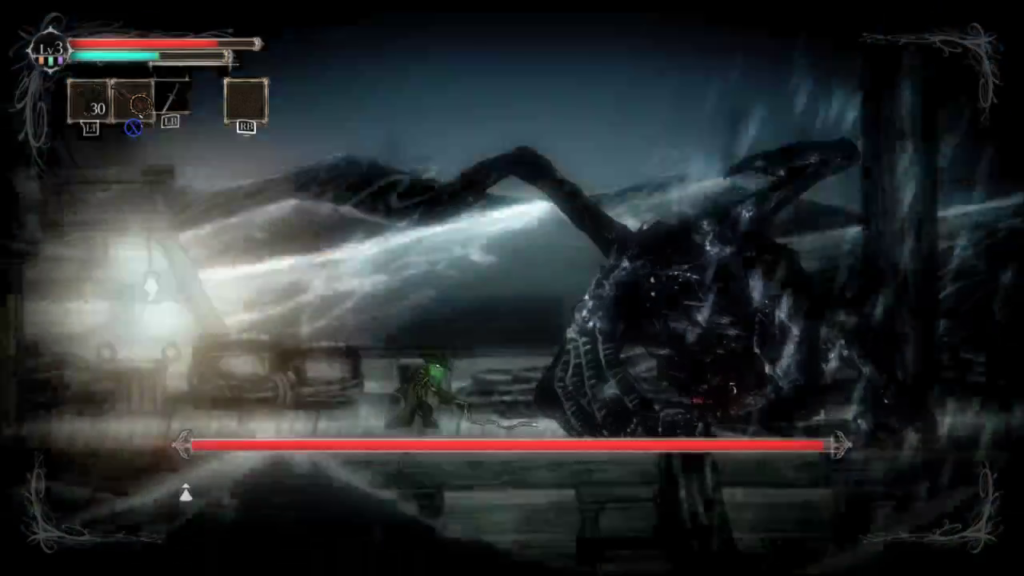
It may have platforming, but Salt and Sanctuary is primarily an action RPG and, despite having one less dimension, many of its mechanics will be very familiar to Dark Souls fans. You can block and parry, dodge roll for invincibility frames, swap between two weapon sets on the fly, and even chug healing potions which refresh every time you rest at a sanctuary. While sanctuaries are bonfires, grains of salt are souls, experience points which you risk dropping if you are killed before cashing them in at a sanctuary. Other shared factors are also present, like equipment weight affecting your maneuverability and each weapon’s damage scaling at a certain rate based on one or two stats.
Direct co-op and PvP are limited strictly to local play, but asynchronous multiplayer is alive and well. Message bottles can be placed around for other players, you can interact with grave markers to see a ghostly image of how someone died, corpses of players are hanged, impaled, or otherwise scattered about near where they died, and, in a clever and subtle twist on fog doors, boss fights are marked by candelabras with the number of lit candles indicated the success/failure ratio for the fight (less candles means more failed attempts).
The general flow of combat is likewise similar too. Fighting has a methodical pace to it where you need to wait for the opportune moment to strike and learn when to retreat. Actions must be chosen with care as attacking, dodging, running, and blocking all draw from the same replenishing stamina bar. Enemies hit hard enough that even the weaker ones should be taken seriously and deaths are frequent while rarely feeling cheap. Every melee weapon has a heavy attack and a normal attack combo and, in most cases, special attacks like popping enemies into the air can be performed by chaining the two together. It certainly feels like Dark Souls combat, but it’s not quite the same. Even though combat in Salt and Sanctuary is methodical and rewards patience, there’s a faster overall flow to it and being overly cautious can often punish you just as severely as recklessly rushing in.

Salt and Sanctuary still has plenty of its own ideas alongside twists on old ones. To begin with, let’s take a look at, well, salt and sanctuaries. Salt can sometimes be found in consumable containers, but it’s mostly obtained from enemies and used at sanctuaries to level up or upgrade equipment. However, just what happens to that salt when you die is rather unique because you must fight to get it back. Whenever you die from fall damage or some other environmental hazard your lost salt reforms into a salt bat at your death location.
These bats aren’t all that threatening on their own and it only takes about two hits to kill them and reclaim your salt, but they can be difficult to deal with if enemies are nearby and they can definitely end up pushing you straight into the same pit or trap which killed you the first time around. Meanwhile, if an enemy kills you it becomes empowered by your salt, taking on a salty aura which grants it additional health and attack power; bosses have a marker on their health bars which you need to reduce their health to in order to reclaim your salt. In other words, Salt and Sanctuary doesn’t just task players to do as well as their previous attempt, it demands that they learn from their mistakes to overcome an even more difficult challenge.
Sanctuaries are checkpoints and factions rolled into one convenient package and there are three types. First, there are what I’ll call the “minor sanctuaries”, places where you can rest to heal up and restock your main potions at the cost of enemies respawning; minor sanctuaries have no NPC’s and you can’t even level up at them, simple enough. Next are the claimed sanctuaries, places which already belong to a specific faction and have at least one NPC; you can rest at claimed sanctuaries, level up, and buy stuff from NPC’s even if you don’t belong to the faction in question. Last of all are unclaimed sanctuaries which you can convert into ones belonging to your current faction by placing your faction’s idol on an altar in the center.
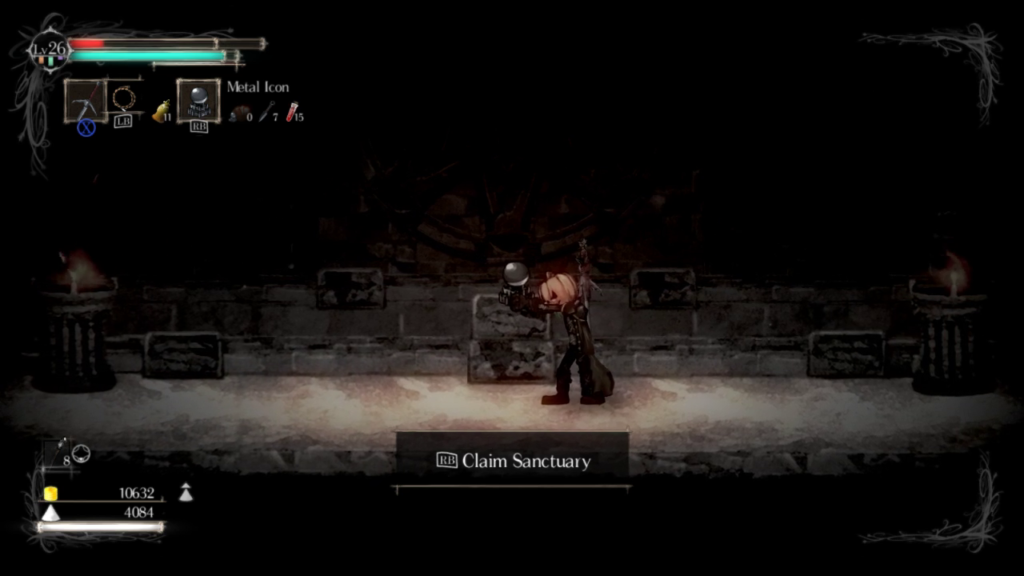
You can permanently summon up to four NPC’s to any sanctuary under the control of your current faction and, if you don’t mind doing a bit of grinding, enemy trophies can be cashed in at your faction’s leader to boost your potion uses and unlock new equipment, consumables, and spells in the shops. You can easily swap to any faction at one of its sanctuaries at any time, though going back to a previous faction requires you to pay a small penance to a specific NPC, a trivial and somewhat tedious holdover from the Souls formula which feels unnecessary.
Salt and Sanctuary‘s skill tree is one of its defining features. Taking on the shape of a literal tree with nodes forming its branches and roots, this thing is truly massive. Each time you level up you gain a black pearl, pearls can also sometimes be found in the environment, and most of the time this translates into filling in a single node on the tree. The majority of these nodes give you a point in a specific stat, which is admittedly not all that exciting even if they do add up. There are three places where things get more interesting though. First of all, each of these stat nodes can be invested in three times so if you’d really like to double down on one or two specific stats instead of branching out you’re free to do so, a feature which is especially handy for New Game+. Secondly, potion nodes exist which grant you additional health or magic potions, making these nodes particularly valuable assets to hunt down. The third type of node ties in with proficiency.
You can technically use any equipment you find, but it won’t help much at all if you don’t have the proficiency for it. Magic, prayers, the three types of armor, and the many types of weaponry are each divided between five tiers, plus a default “Class 0″ tier” for some of the very basic gear. Unlocking access to a tier requires you to invest in its node on the skill tree and these nodes in turn require a number of points equal to their rank. There are plenty of branches so players still have plenty of control over which stats they gain along the way and each proficiency node boosts a specific stat by its tier rank (ex: Tier 5 sword proficiency gives five points of strength), though this system does still encourage players to commit to a specific build.
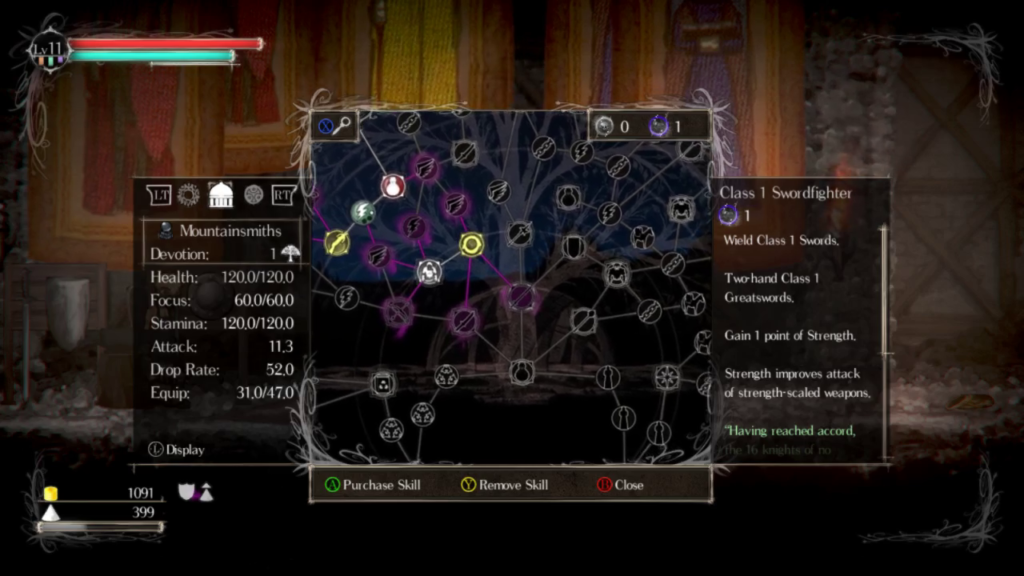
A variety of early weapons exist to play around with and you can find grey pearls to reset points so you’re unlikely to get locked into a build you end up hating, though there is one issue related to weapon scaling. Namely, some of the Tier 5 weapons scale primarily with unexpected stats, such as the only Tier 5 dagger in the game scaling half with dexterity and half with wisdom, which can be frustrating if you haven’t invested in every stat.
The health and magic systems have some very neat quirks. Attacks are able to reduce your maximum health and it will only go back to full after resting at a sanctuary. You never lose much from a single hit, but it does add up, especially during boss fights. I like this mechanic quite a lot as it’s one of the ways in which Salt & Sanctuary discourages players from leaning too heavily on shields and potions. You can certainly play defensively if you want to, but dragging out a fight too long is going to result in having a whole lot less leeway for your health bar.
As for magic, your stamina bar is linked to your mana bar. Every time you cast a spell your mana bar, called focus, depletes and your maximum stamina goes with it. The focus bar is equal to roughly half of the stamina bar, though the exact ratio and the maximum amount of stamina you can lose varies based on your equipment and stats. This makes for a more interesting tradeoff than a standard mana system or casting limit as spells allow mages to have great range, utility, and damage, but at the cost of defense, mobility, and physical offense. It’s a fantastic way to implement spellcasters in an action game.
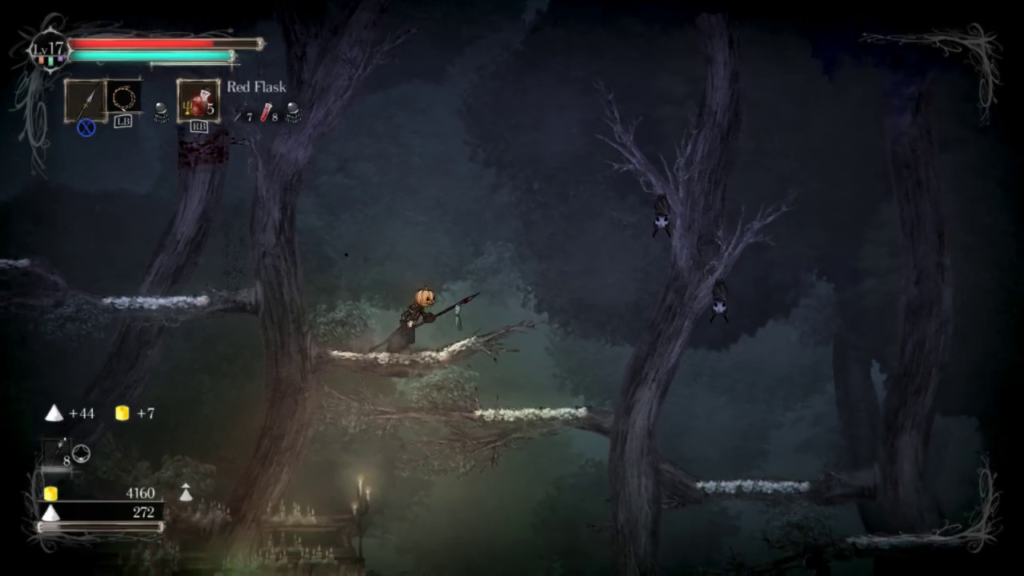
There is a dedicated jump button. I cannot stress enough how important this is to shaping Salt and Sanctuary‘s gameplay. Sure, Dark Souls has a sense of verticality, but it’s purely on a macro scale, a feeling of gradually ascending and descending. Salt and Sanctuary has that too, but its verticality also exists on the micro scale. Uneven terrain and floating platforms allow for some serious combat variety which wouldn’t be possible without jumping.
One of the first places where the significance of a jump button really shines through is a forest where you fight archers primarily on small platforms far above the ground. Not only do you jump between platforms to close the gap, but avoiding arrows by jumping proves to be far more satisfying than simply blocking or rolling for invincibility frames. What’s more, the archers themselves love to jump between platforms, giving these fights a great sense of mobility without taking away from the overall methodical feel. Jumping also allows for more vertical combat, whether you’re popping enemies off the ground in the middle of a combo or jumping up to slash at flying foes. Beyond that, its presence allows enemies to have more demanding attacks which shields or invincibility frames from rolls aren’t always enough to counter. It allows for the presence of pits, tripwires, and other environmental hazards which shape the way you approach each fight. Plus, jumping is simply fun.
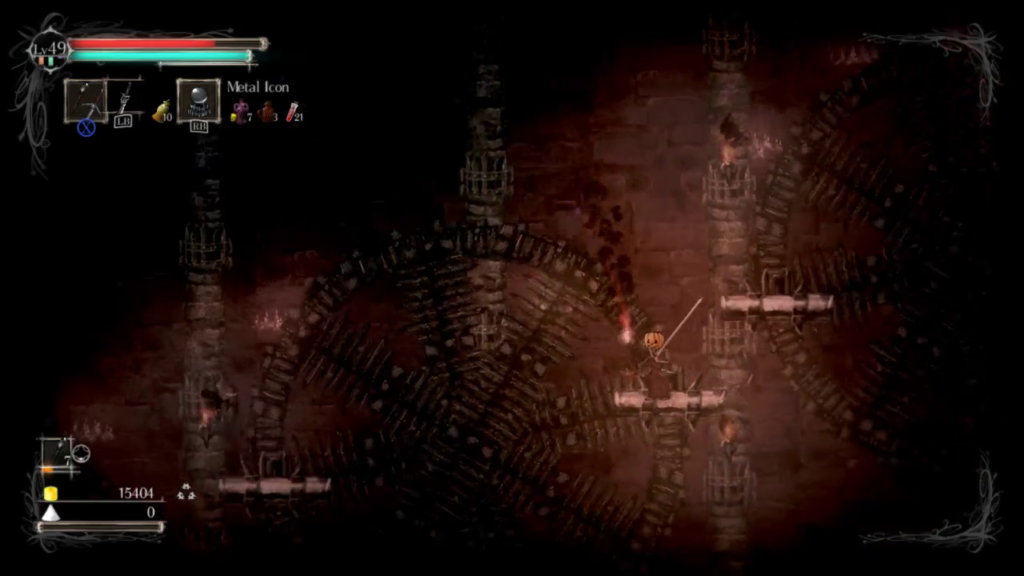
As much of a boon as jumping is to the combat system, platforming is something of a mixed bag overall. Let’s start with the positive. To begin with, there are a few skills you find along your journey. Several of these tie directly in with jumping, such as a wall jump and an aerial dash and every upgrade results in new, interesting challenges. The controls are responsive and the presence of platforming helps to really highlight the sense of scale at play here as you ascend and descend the island’s many structures. Many enemies also become far more dangerous once fall damage becomes a concern; overly defensive play can very well result in blocking an attack only to die after being flung off a ledge by the impact, leading to a very smooth combat flow.
The downsides to the platforming revolve around the camera and ledge grabbing. Generally speaking, the camera is fine. It’s zoomed out at a comfortable distance and you are free to move it around to check above and below you. Unfortunately, every once in a while a platform is placed so far away that you can’t see it even after moving the camera as far down as it will go. Sometimes there is a subtle environmental clue, like a candle, to give you an idea of the platform’s whereabouts, but these clues can be so subtle that are easy to misinterpret. Other times it feels like there are simply no clues at all, in which case you must make a truly blind jump and hope for the best. These jumps are rare and mostly tied to optional paths, but they’re never fun to come across. Ledge grabbing is a more severe, and far more prevalent, issue.

Grabbing onto ledges when jumping across gaps works well enough, but it can be incredibly finicky when you’re trying to grab a platform above you. This is especially true for thin platforms which are directly lined up horizontally as you’ll need to jump partially through the platform, navigate to the edge, and quickly turn around all in one motion and really, really hope that your character decides to grab the ledge.
Your character also takes quite a while to pull themselves up onto platforms, which is very frustrating when crumbling platforms are involved as you have virtually no time to react once your character finishes climbing up; ledge grabs on crumbling platforms results in a boss called The Tree of Men being both a fantastic concept and by far the worst fight in the game. All of this becomes infinitely worse when Mega Man-style disappearing platforms are thrown into the mix to add a tight timing element to an already unreliable mechanic.
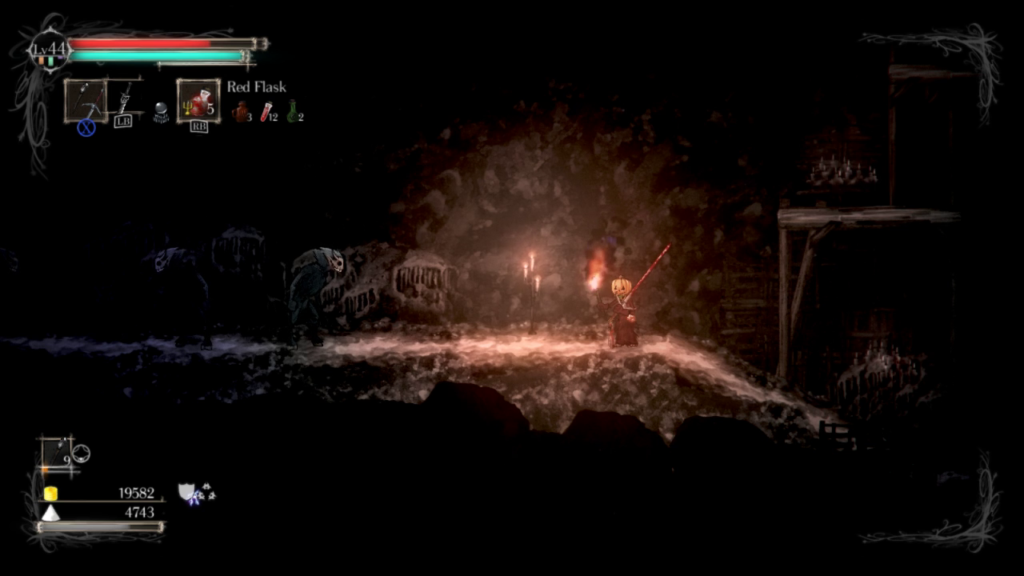
Salt and Sanctuary really excels at tone. The perpetual mist and washed out color palette work well together to create an all-encompassing gloom. light and darkness play large roles as the game loves to send players into caverns and other places with limited visibility where, unless you have the right spell or accessory, a hand must be used for the sake of carrying a torch instead of a shield or weapon, making you feel far more vulnerable. Sound effects are very visceral, you can practically feel the impact after your character falls too far, and the music outside of boss fights is largely muted or atmospheric in nature.
More than anything else, the tone is one of futility. The exploration aspect particularly plays into building up this tone. You’re sometimes ascending and very frequently descending here and the game cleverly uses horizontal space and gently sloping platforms to trick players into thinking they’re traveling farther than they actually are. So often while playing I would descend through a place and then descend even deeper into somewhere below that only to open a door and step through onto the island’s surface in an area I had left behind hours ago. The shortcuts are certainly handy, yet they reinforce the notion of being helplessly trapped on this horrible island. NPC’s further contribute to the tone because, just like you, they were all lost at sea while on some mission or other, or at least they think they were, and, just like you, they want to get off the island and have no idea how. The piles upon piles of corpses scattered about are certainly worrying and even many of the undead enemies enhance the tone with named like “Drowned Peasant” and “Drowned Soldier”. Just how much does that princess matter anyway?
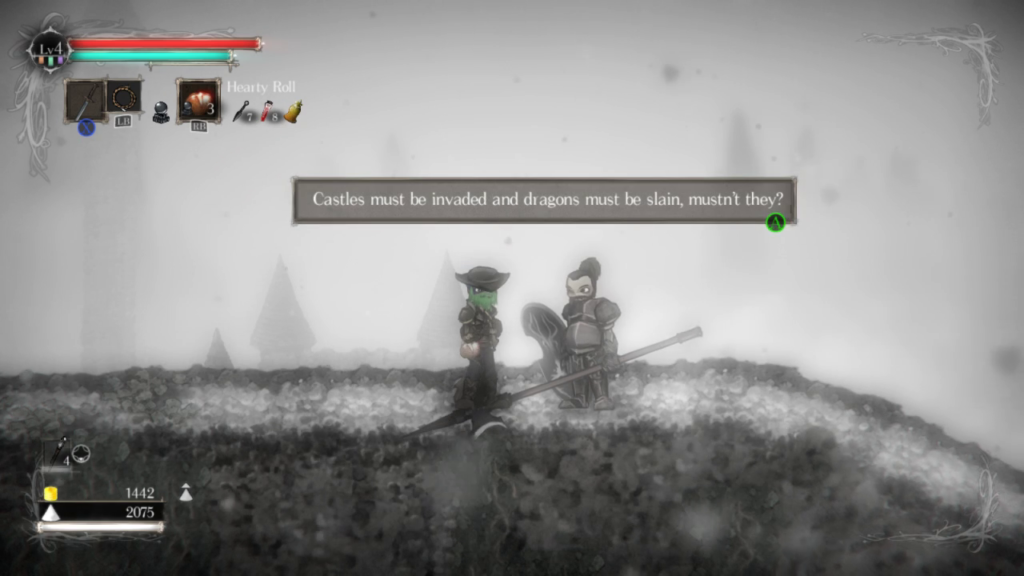
Last of all, let’s talk about lore. I want to avoid spoilers here so I won’t be going too deep into the details, but if you’re a fan of passive storytelling then you’ll love Salt and Sanctuary. Everything has flavor text, and I do mean everything. Equipment has lore, crafting materials and monster trophies have lore, even every single node on the skill tree has lore. There are a few NPC’s with their own story arcs wandering around, but each of the seemingly generic merchant NPC’s and the like for every faction has a story to tell as well.
Every faction has slightly different refilling health and mana potions as well which, in addition to having slightly varied effects (ex: quickly healing a moderate amount versus slowly healing a large amount), each come with their own bits of flavor text. A full-fledged bestiary is also accessible at any time, making the many grisly enemy designs even more morbid. This is a setting with a living, breathing world and much of the information you can find is engaging. Of course, you’re also entirely free to ignore nearly all the text and have some fun fighting undead horrors, that’s the power of passive storytelling.
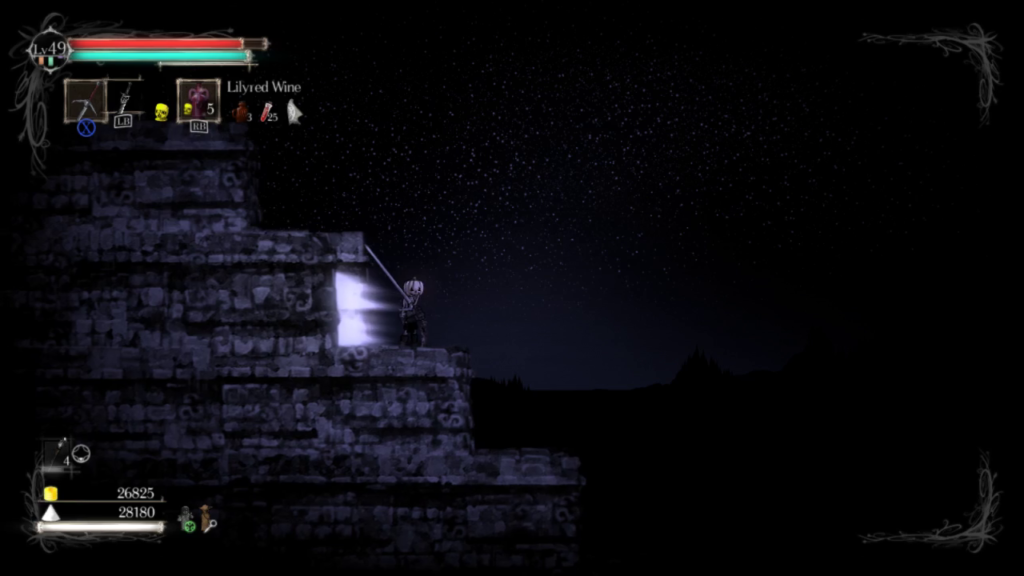
Salt and Sanctuary cleaves more closely to the original Dark Souls formula than any other indie game I have played, yet it nevertheless still finds plenty of ways to add to it, to twist things around, and to take entirely new risks. As a result, it’s an incredibly strong entry within this growing action RPG niche (Souls-likes?) and an indie game classic which I believe will withstand the test of time for many years to come.